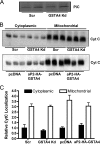Protein carbonylation and adipocyte mitochondrial function
- PMID: 22822087
- PMCID: PMC3463318
- DOI: 10.1074/jbc.M112.400663
Protein carbonylation and adipocyte mitochondrial function
Abstract
Carbonylation is the covalent, non-reversible modification of the side chains of cysteine, histidine, and lysine residues by lipid peroxidation end products such as 4-hydroxy- and 4-oxononenal. In adipose tissue the effects of such modifications are associated with increased oxidative stress and metabolic dysregulation centered on mitochondrial energy metabolism. To address the role of protein carbonylation in the pathogenesis of mitochondrial dysfunction, quantitative proteomics was employed to identify specific targets of carbonylation in GSTA4-silenced or overexpressing 3T3-L1 adipocytes. GSTA4-silenced adipocytes displayed elevated carbonylation of several key mitochondrial proteins including the phosphate carrier protein, NADH dehydrogenase 1α subcomplexes 2 and 3, translocase of inner mitochondrial membrane 50, and valyl-tRNA synthetase. Elevated protein carbonylation is accompanied by diminished complex I activity, impaired respiration, increased superoxide production, and a reduction in membrane potential without changes in mitochondrial number, area, or density. Silencing of the phosphate carrier or NADH dehydrogenase 1α subcomplexes 2 or 3 in 3T3-L1 cells results in decreased basal and maximal respiration. These results suggest that protein carbonylation plays a major instigating role in cytokine-dependent mitochondrial dysfunction and may be linked to the development of insulin resistance in the adipocyte.
Figures








Similar articles
-
Downregulation of adipose glutathione S-transferase A4 leads to increased protein carbonylation, oxidative stress, and mitochondrial dysfunction.Diabetes. 2010 May;59(5):1132-42. doi: 10.2337/db09-1105. Epub 2010 Feb 11. Diabetes. 2010. PMID: 20150287 Free PMC article.
-
Proinflammatory cytokines differentially regulate adipocyte mitochondrial metabolism, oxidative stress, and dynamics.Am J Physiol Endocrinol Metab. 2014 May 1;306(9):E1033-45. doi: 10.1152/ajpendo.00422.2013. Epub 2014 Mar 4. Am J Physiol Endocrinol Metab. 2014. PMID: 24595304 Free PMC article.
-
Peroxiredoxin 3 is a key molecule regulating adipocyte oxidative stress, mitochondrial biogenesis, and adipokine expression.Antioxid Redox Signal. 2012 Feb 1;16(3):229-43. doi: 10.1089/ars.2010.3766. Epub 2011 Oct 17. Antioxid Redox Signal. 2012. PMID: 21902452 Free PMC article.
-
Protein carbonylation, mitochondrial dysfunction, and insulin resistance.Adv Nutr. 2013 Mar 1;4(2):157-63. doi: 10.3945/an.112.003319. Adv Nutr. 2013. PMID: 23493532 Free PMC article. Review.
-
Protein carbonylation and metabolic control systems.Trends Endocrinol Metab. 2012 Aug;23(8):399-406. doi: 10.1016/j.tem.2012.05.008. Epub 2012 Jun 27. Trends Endocrinol Metab. 2012. PMID: 22742812 Free PMC article. Review.
Cited by
-
Oxidative stress and lipotoxicity.J Lipid Res. 2016 Nov;57(11):1976-1986. doi: 10.1194/jlr.R066597. Epub 2016 Mar 23. J Lipid Res. 2016. PMID: 27009116 Free PMC article. Review.
-
Histone Carbonylation Is a Redox-Regulated Epigenomic Mark That Accumulates with Obesity and Aging.Antioxidants (Basel). 2020 Dec 1;9(12):1210. doi: 10.3390/antiox9121210. Antioxidants (Basel). 2020. PMID: 33271806 Free PMC article.
-
Oxidative stress and protein carbonylation in adipose tissue - implications for insulin resistance and diabetes mellitus.J Proteomics. 2013 Oct 30;92:323-34. doi: 10.1016/j.jprot.2013.04.002. Epub 2013 Apr 11. J Proteomics. 2013. PMID: 23584148 Free PMC article. Review.
-
The effect of glucose concentration and sodium phenylbutyrate treatment on mitochondrial bioenergetics and ER stress in 3T3-L1 adipocytes.Biochim Biophys Acta. 2015 Jan;1853(1):213-21. doi: 10.1016/j.bbamcr.2014.10.012. Epub 2014 Oct 22. Biochim Biophys Acta. 2015. PMID: 25448036 Free PMC article.
-
Sustained caloric restriction potentiates insulin action by activating prostacyclin synthase.Obesity (Silver Spring). 2024 Dec;32(12):2286-2298. doi: 10.1002/oby.24150. Epub 2024 Oct 17. Obesity (Silver Spring). 2024. PMID: 39420421 Free PMC article.
References
-
- Bonadonna R. C., Groop L., Kraemer N., Ferrannini E., Del Prato S., DeFronzo R. A. (1990) Obesity and insulin resistance in humans. A dose-response study. Metab. Clin. Exp. 39, 452–459 - PubMed
-
- Houstis N., Rosen E. D., Lander E. (2006) Reactive oxygen species have a causal role in multiple forms of insulin resistance. Nature 440, 944–948 - PubMed
-
- Fang J., Holmgren A. (2006) Inhibition of thioredoxin and thioredoxin reductase by 4-hydroxy-2-nonenal in vitro and in vivo. J. Am. Chem. Soc. 128, 1879–1885 - PubMed
Publication types
MeSH terms
Substances
Grants and funding
LinkOut - more resources
Full Text Sources

